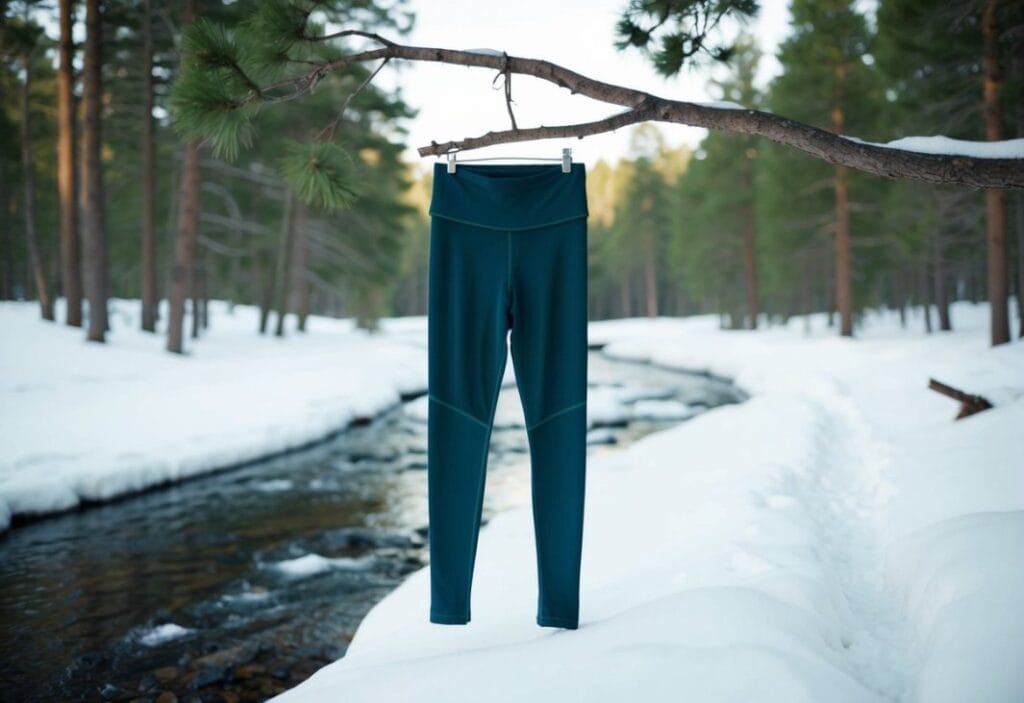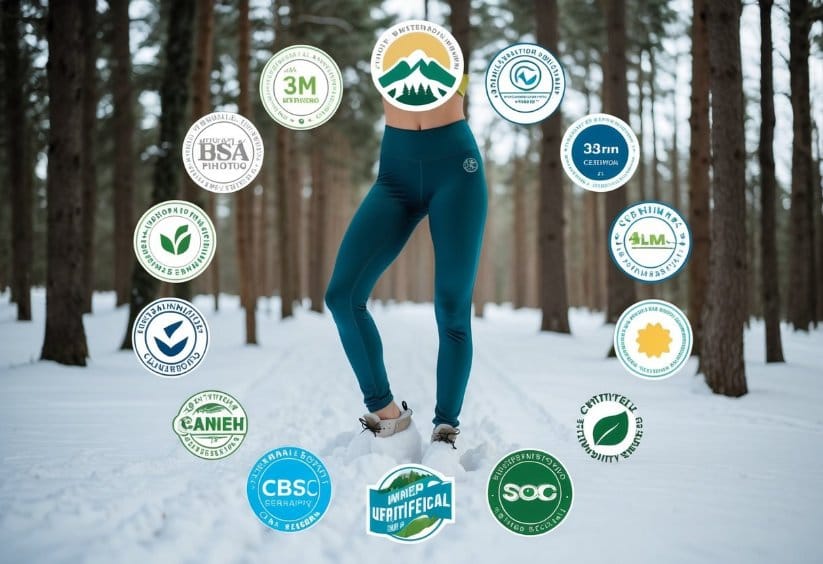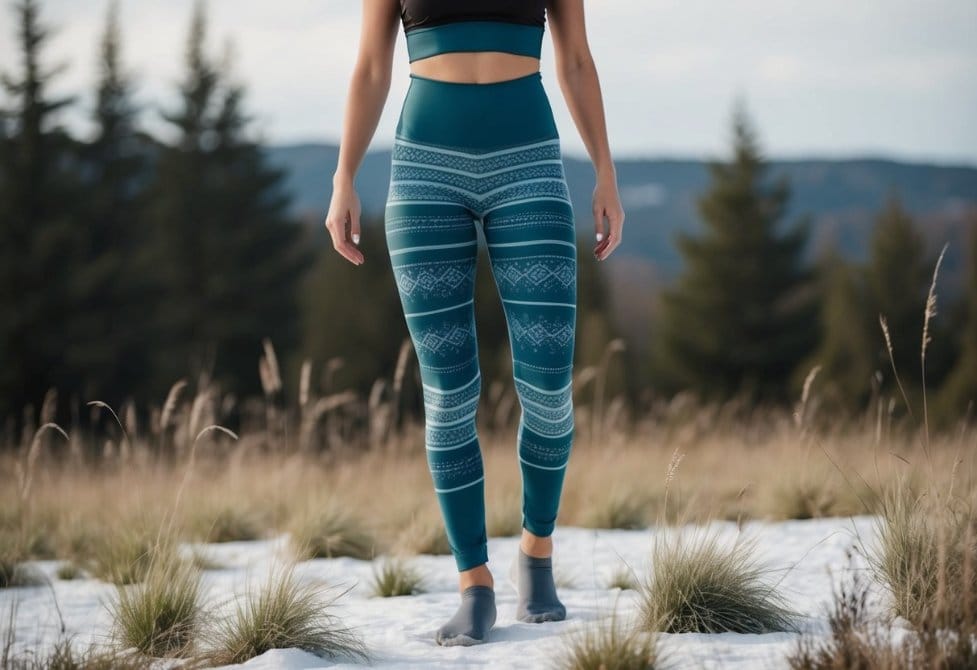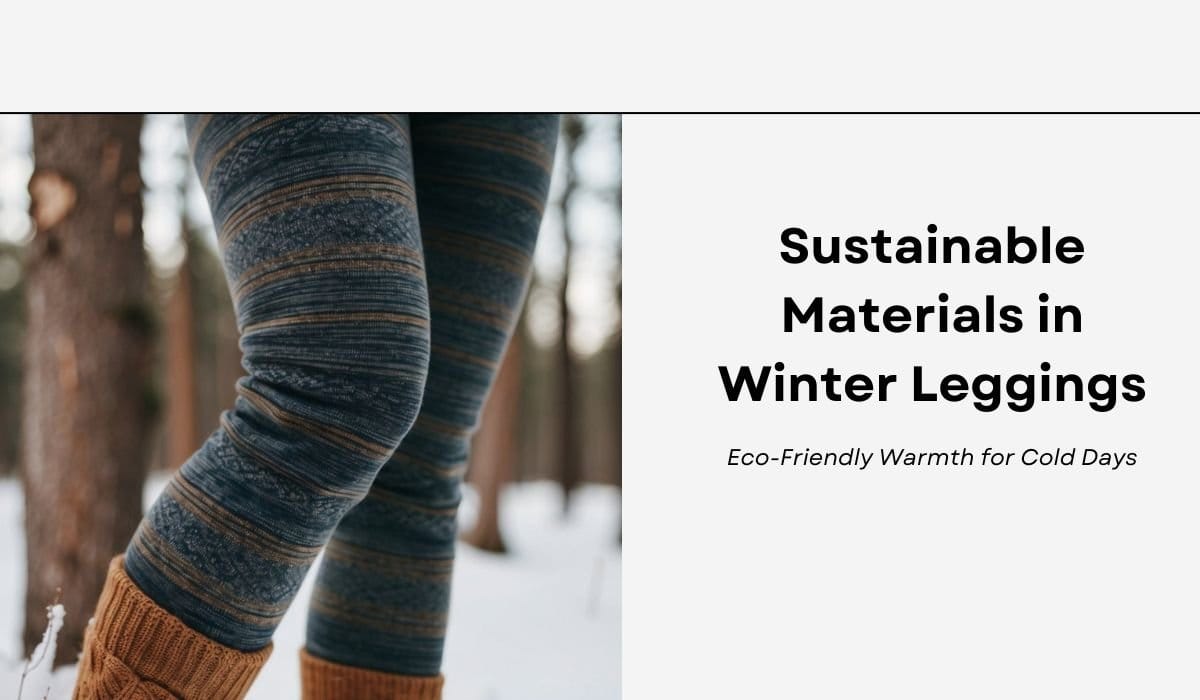Green Fashion Meets Winter Performance – A Guide to Earth-Conscious Cold Weather Gear
As winter approaches, many people seek comfortable and warm clothing options. Leggings are a popular choice, but their environmental impact is often overlooked. Sustainable materials in winter leggings offer a solution to this problem, providing both comfort and eco-friendliness.
Sustainable winter leggings are made from materials like organic cotton, bamboo, and recycled polyester, which have a lower environmental impact than traditional synthetic fabrics. These materials are often produced using less water and fewer chemicals, making them a more responsible choice for eco-conscious consumers. Some brands also use innovative materials like Tencel, which is derived from wood pulp and biodegradable.
When shopping for sustainable winter leggings, look for certifications such as GOTS (Global Organic Textile Standard) or Oeko-Tex Standard 100. These certifications ensure that the leggings are made from organic materials and produced in an environmentally friendly manner. It’s also worth considering the brand’s overall commitment to sustainability, including their packaging and production practices.
On This Page
Key Takeaways
- Sustainable winter leggings use eco-friendly materials like organic cotton and recycled polyester
- Certifications such as GOTS and Oeko-Tex Standard 100 help identify truly sustainable leggings
- Brands committed to sustainability often use eco-friendly packaging and production methods
Understanding Sustainable Materials

Sustainable materials in winter leggings offer eco-friendly alternatives to traditional fabrics. These options reduce environmental impact while providing comfort and durability for cold-weather wear.
Organic Cotton and Its Impact
Organic cotton is grown without harmful pesticides or synthetic fertilisers. It uses less water than conventional cotton and promotes healthier soil. Organic cotton leggings are soft, breathable, and biodegradable.
Benefits of organic cotton: • Chemical-free cultivation • Lower water consumption • Improved soil health • Biodegradable material
Farmers who grow organic cotton often use crop rotation methods. This practice helps maintain soil nutrients naturally. Organic cotton leggings may cost more, but they last longer and are gentler on the skin.
Recycled Polyester Explained
Recycled polyester comes from plastic bottles and other post-consumer waste. It keeps plastics out of landfills and oceans. The process of making recycled polyester uses less energy than creating new polyester.
How recycled polyester is made:
- Collect plastic bottles
- Clean and shred into flakes
- Melt flakes into pellets
- Spin pellets into yarn
Recycled polyester leggings are moisture-wicking and durable. They’re ideal for intense workouts or cold weather activities. This material helps reduce reliance on fossil fuels used in traditional polyester production.
Tencel Lyocell and Bamboo Fibres
Tencel lyocell is made from wood pulp, often from eucalyptus trees. Bamboo fibres come from fast-growing bamboo plants. Both are renewable resources that require less water than cotton to produce.
Tencel lyocell features: • Soft texture • Moisture-wicking • Antibacterial properties • Biodegradable
Bamboo leggings are known for their silky feel and thermal regulation. They keep wearers warm in winter and cool in summer. Both materials are breathable and resist odours, making them great for activewear.
Tencel production uses a closed-loop system that recycles water and solvents. This process is more eco-friendly than many other fabric manufacturing methods. Bamboo grows quickly without pesticides, making it a sustainable crop choice.
The Importance of Certifications

Certifications play a key role in ensuring sustainable and ethical practices in winter legging production. They provide consumers with trustworthy information about materials and manufacturing processes.
GOTS Certified Organic Cotton
GOTS (Global Organic Textile Standard) certification is a crucial mark of quality for organic cotton used in winter leggings. It guarantees that the cotton is grown without harmful pesticides or synthetic fertilisers. GOTS also sets strict rules for water use and soil health.
Leggings made with GOTS certified cotton are softer and more breathable. They’re better for sensitive skin too. The certification covers the entire supply chain, from farming to final product. This means every step meets high environmental and social standards.
Some brands, like Seasalt, have achieved GOTS certification for their organic cotton leggings. This shows their commitment to sustainability and transparency.
Fair Trade and Social Accountability
Fair Trade certification ensures workers receive fair wages and work in safe conditions. It helps create sustainable livelihoods for farmers and factory workers. Social Accountability International (SAI) sets global standards for ethical working conditions.
These certifications look at:
- Fair wages
- Safe working environments
- No child labour
- Freedom of association
Brands with these certifications show they care about the people making their leggings. Happy Earth Apparel, for example, uses Fair Trade certified materials in their products.
Certifications like these help consumers make informed choices. They support brands that prioritise both environmental and social responsibility in their winter legging production.
Design and Comfort Features

Sustainable winter leggings blend eco-friendly materials with practical designs. They offer warmth and style while prioritising comfort and performance.
High-Waisted and Pocketed Leggings
High-waisted leggings provide extra coverage and support. The higher waistband keeps the tummy tucked in and prevents sagging during movement. Many brands now include pockets in their designs.
These pockets are perfect for carrying small items like keys or phones. Some leggings feature deep side pockets, while others have hidden waistband pockets. The added storage makes these leggings ideal for everyday wear or light exercise.
Sustainable brands use recycled materials to create these functional designs. This helps reduce waste while offering the same comfort and style as traditional leggings.
Performance Leggings for Athletic Wear
Performance leggings are made for intense workouts and cold weather activities. They use moisture-wicking fabrics to keep the wearer dry and comfortable. These materials pull sweat away from the skin, helping to regulate body temperature.
Many sustainable athletic leggings are made from recycled plastic bottles. This eco-friendly option offers the same stretch and support as standard synthetic fabrics. Some brands add compression features to boost blood flow and reduce muscle fatigue.
Thermal options use special insulating fabrics to trap heat close to the body. This makes them ideal for outdoor winter sports or chilly morning runs. Despite their warmth, these leggings remain breathable to prevent overheating during exercise.
Environmental Concerns in Textile Production
The textile industry faces major environmental challenges. Two key issues are the release of microplastics and the generation of textile waste. These problems affect ecosystems and contribute to pollution worldwide.
The Issue of Microplastics
Synthetic fabrics shed tiny plastic fibres when washed. These microplastics enter waterways and harm marine life. Studies show a single load of laundry can release thousands of plastic particles. Many winter leggings contain synthetics like polyester and nylon that contribute to this issue.
Some brands now use recycled plastics to make leggings. This helps reduce plastic waste but doesn’t solve the microfibre problem. Filters on washing machines can catch some microfibres. Natural fibres like wool and cotton don’t shed microplastics. But they have other environmental impacts to consider.
Textile Waste and Circular Fashion
The fashion industry produces massive amounts of textile waste. Unsold clothes often end up in landfills. Fast fashion leads to garments being quickly discarded. In the UK, about 350,000 tonnes of clothes go to landfill each year.
Circular fashion aims to reduce this waste. It involves:
- Using recycled materials
- Designing clothes to last longer
- Repairing and upcycling garments
- Recycling old textiles into new ones
Some brands now make leggings from recycled plastic bottles or fishing nets. Others use plant-based materials that break down more easily. Rental and resale programmes also help extend the life of clothes.
Lifestyle Considerations for Eco-Friendly Leggings
Eco-friendly leggings offer options for various activities and lifestyles. The fabrics used in these sustainable garments provide comfort and functionality for different needs.
Activewear Versus Lounging Options
Eco-friendly workout leggings are designed for high-impact activities. They often use recycled materials like polyester or nylon mixed with a small amount of spandex for stretch. These fabrics wick sweat and allow freedom of movement during exercise.
For lounging, organic cotton blends are popular. They’re soft and breathable, perfect for relaxing at home. Some brands offer thermal options with recycled polyester linings for added warmth.
Workout leggings typically have more compression and reinforced seams. Loungewear styles are usually looser and focus on comfort over performance features.
The Versatility of Eco-Friendly Fabrics
Sustainable leggings can be worn for many occasions. Recycled polyester and organic cotton blends work well for both active and casual wear.
These eco-friendly fabrics often have moisture-wicking properties, making them suitable for light exercise or running errands. They’re also durable, maintaining their shape after many washes.
Some brands use innovative materials like ROICA™ V550, an eco-friendly alternative to spandex. This fabric uses less energy to produce and has a lower carbon footprint.
Eco-friendly leggings can be styled with different outfits. They pair well with oversized jumpers for a relaxed look or with a fitted top for the gym.
The Role of Sustainable Brands in Fashion
Sustainable fashion brands are changing the industry by using eco-friendly materials and ethical practices. They focus on reducing environmental impact and improving worker conditions. These brands offer stylish options that align with consumers’ values.
Prominent Sustainable Fashion Brands
Girlfriend Collective stands out in the sustainable fashion world. They make leggings from recycled plastic bottles. Their products are both stylish and kind to the planet.
Patagonia is another leader in sustainable outdoor wear. They use recycled materials and organic cotton in their clothes. The brand is known for its repair and reuse programmes.
BEDI makes winter wear from recycled fabrics. They aim to cut down on textile waste and carbon emissions. Their coats and jackets are warm and eco-friendly.
Happy Earth Apparel and Ethics
Happy Earth Apparel puts ethics at the heart of its business. They use organic and recycled materials in their clothes. The brand focuses on fair labour practices and giving back to communities.
Their leggings are made from sustainable fabrics like organic cotton. They avoid harmful dyes and chemicals in production. Happy Earth Apparel also works to reduce packaging waste.
The brand supports various environmental causes. They plant trees for each purchase made. This helps offset carbon emissions from their operations.
The Impact of Leggings on the Environment
Leggings production can affect the planet in major ways. Material choices and manufacturing practices play key roles in determining how eco-friendly leggings are.
Reducing Carbon Footprint through Material Choice
Traditional leggings often use synthetic fabrics like polyester. These materials come from fossil fuels and release greenhouse gases during production. Switching to plant-based fabrics can cut carbon emissions. Organic cotton uses less water and no harmful pesticides. Bamboo grows fast without extra water or chemicals.
Some brands now use innovative eco-materials. Tencel comes from wood pulp and needs less energy to make. Hemp is another earth-friendly option that grows easily. These natural fibres break down faster at the end of their life, unlike synthetics that can take hundreds of years to decompose.
Environmental Benefits of Recycled Fabrics
Using recycled materials in leggings helps the planet. It keeps plastic bottles and old clothes out of landfills. Making new polyester from recycled plastic uses 59% less energy than virgin polyester.
Recycled nylon comes from old fishing nets and carpets. This stops plastic waste from harming sea life. Some companies even make leggings from recycled coffee grounds. This gives a second life to waste that would otherwise end up in the bin.
Recycled fabrics also save water. Making one pair of leggings from recycled polyester can save up to 90 litres of water compared to using new materials.
Challenges and Innovations in Sustainable Leggings
Creating eco-friendly leggings faces hurdles, but new solutions are emerging. Brands are tackling chemical concerns and developing greener dye methods.
Addressing PFAS in Clothing
PFAS chemicals in leggings pose risks to health and the environment. These substances can leach into water and soil. Many companies now offer PFAS-free leggings as a safer choice.
Pact sells non-toxic leggings made from organic cotton. They avoid harmful chemicals in their production. Other brands use natural fibres like bamboo or Tencel to create PFAS-free options.
Testing for PFAS can be tricky. Firms are working on better ways to check for these chemicals. This helps ensure leggings are truly PFAS-free.
Innovations in Sustainable Dye Practices
Dyeing leggings often uses lots of water and energy. New methods aim to cut this impact. Low-impact dyes reduce water waste and pollution.
Some firms now use waterless dyeing. This saves huge amounts of water. Others recycle dye water to lessen their footprint.
Natural dyes from plants are gaining ground. These create unique colours without harsh chemicals. Mushroom and algae dyes show promise for sustainable fashion.
Digital printing on fabric saves water and dye. It allows for detailed designs with less waste. This tech is improving for use on stretchy legging fabrics.
Ethical Production and Consumer Impact
Sustainable winter leggings involve more than just eco-friendly materials. Ethical manufacturing and informed consumer choices play vital roles in creating positive change in the fashion industry.
Ethical Manufacturing Processes
Many brands now prioritise ethical production for their leggings. Fairtrade-certified factories ensure workers receive fair wages and safe working conditions. Some companies use closed-loop systems to minimise waste and water usage. Others focus on local production to reduce transport emissions.
Patagonia, for example, works with suppliers who meet strict labour and environmental standards. They conduct regular audits to maintain these high expectations. Girlfriend Collective produces their recycled polyester leggings in factories that guarantee fair wages and ban child labour.
Ethical leggings often come with a higher price tag. This reflects the true cost of responsible production, including fair pay and sustainable practices.
Consumer’s Role in Promoting Ethical Practices
Shoppers can drive change by supporting brands with strong ethical policies. Research is key – look for clear information about a company’s manufacturing processes and worker treatment.
Some ways to promote ethical practices:
- Buy less, but invest in quality pieces that last longer
- Choose leggings made from recycled materials
- Look for certifications like Fair Trade or GOTS
- Ask brands about their ethical policies
By making informed choices, consumers send a clear message to the fashion industry. This encourages more companies to adopt ethical production methods for winter leggings and other clothing items.
Advocating for Transparency and Accountability
Clear information about sustainable materials in winter leggings is crucial. Consumers deserve to know how their clothes are made and what impact they have on the environment. Companies must be open about their practices and meet industry standards.
Understanding the Supply Chain
Tracking materials from start to finish is key for sustainable winter leggings. Brands should share details on where they source recycled PET and virgin polyester. This helps buyers make informed choices.
Some companies now list the percentage of recycled content in their products. Others explain how they reduce microfibre shedding during washing. These steps show a commitment to openness.
Supply chain maps can reveal weak points where improvements are needed. They also highlight areas where brands are doing well in terms of sustainability.
The Need for Industry-Wide Standards
Common guidelines for sustainable practices in leggings production are essential. Without them, it’s hard to compare different brands’ claims about eco-friendly materials.
A unified approach to measuring environmental impact would benefit everyone. This could include standard ways to assess water usage, carbon emissions, and waste reduction.
Clear labels showing a product’s sustainability score could help shoppers. These might cover factors like durability, recyclability, and use of non-toxic dyes.
Industry groups should work together to create these standards. This would push all companies to be more responsible and transparent.
Frequently Asked Questions
Winter leggings made from sustainable materials offer warmth, comfort and eco-friendly benefits. Let’s explore some common questions about choosing the best options for cold weather.
What fabrics are best for maintaining warmth in winter leggings?
Merino wool is excellent for winter leggings. It’s naturally insulating, moisture-wicking and odour-resistant. Recycled polyester fleece also provides good warmth while using fewer resources.
Bamboo viscose blends offer softness and thermal regulation. They help keep legs warm without overheating.
How eco-friendly are bamboo leggings compared to other materials?
Bamboo grows quickly with little water or pesticides. This makes it more sustainable than conventional cotton.
The processing of bamboo into fabric can involve harsh chemicals. Look for brands using closed-loop systems that reuse water and solvents.
Bamboo leggings often blend with synthetic fibres for stretch. This affects their biodegradability.
What are the benefits of organic cotton in cold weather legwear?
Organic cotton is grown without synthetic pesticides or fertilisers. This protects soil and water quality.
It’s breathable and hypoallergenic, ideal for sensitive skin. Organic cotton wicks moisture to keep you dry and comfortable.
Thicker organic cotton leggings provide moderate warmth for milder winter days.
Are there sustainable options for non see-through leggings suitable for winter?
Yes, several eco-friendly materials make opaque winter leggings. Thick organic cotton and bamboo blends offer coverage and warmth.
Recycled nylon or polyester with a brushed interior lining creates non see-through options. These materials repurpose plastic waste.
Look for leggings with at least 20% elastane for stretch without becoming sheer.
What features should I look for in sustainable leggings with pockets?
Choose leggings with pockets made from the same eco-friendly fabric as the main garment. This ensures consistent sustainability.
Deep, secure pockets are useful for carrying essentials. Side pockets work well for phones or keys.
Reinforced stitching around pockets improves durability. This extends the life of your sustainable leggings.
Which thick materials in leggings are both warm and environmentally responsible?
Recycled wool blends offer excellent warmth and use less energy to produce. They’re a great choice for very cold days.
Organic cotton fleece provides cosy insulation. It’s biodegradable and grown without harmful chemicals.
Thick bamboo-based fabrics with added recycled synthetics balance warmth and sustainability. They’re soft and temperature-regulating.
Related Post: Eco-Friendly Winter Leggings: Sustainable Warmth for Cold Days

